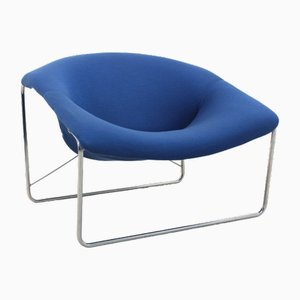
Industrial designer Olivier Mourgue was born in 1939 in Paris, France. He obtained a degree in Interior Design from the Ecole Boulle and in Furniture Design from Ecole Nationale Superieure des Arts Decoratifs in Paris, graduating in 1960. He also trained in Finland and Sweden under Maurice Holland of Nordiska Kompaniet in Stockholm.
In 1963, he began his most fruitful collaboration: working for Airborne International, where he designed his infamous Djinn Series (1965), named after a supernatural Djinn (or genie) from Arabian fairy tales that could assume human or animal form. The collection’s anthropomorphic qualities were representative of a new direction in sculptural furniture design. The most well-known of the series is the undulating Djinn Chair (1965), which found fame after it was featured in Stanley Kubrick’s futuristic film 2001: A Space Odyssey (1968).
Mourgue also worked for the Agence d'Architecture Interieure Gautier-Delaye while at Airborne, before establishing his own studio in 1966, designing furniture for Disderot, Renault, Prisunic, and Mobilier National.
In the 1960s, Morgue became well known for his futuristic and Pop Art inspired furniture that was flexible and practical—he created removable covers in bright colors that were easily changed, providing new identities to his pieces. Mourgue's standout designs from this period include the Bouloum Chair (1969) for Airborne; Joker Lounge Chair (1960s); Whist Chair and Ottoman (1964); Montreal Series (1967); Cubique Chair (1968)—which won the AID International Design Award; and Flower Lamp (1970) for Disderot.
Following in the footsteps of iconic designers Verner Panton (1968 and 1970) and Joe Colombo (1969), the chemical corporation Bayer AG chose Mourgue as the third designer for Visiona—an exhibition held on board a boat during the Cologne Furniture Fair, for which a designer was charged with transforming the exhibition space into a futuristic world. In 1971, Mourgue created an entire natural landscape with carpets and textiles that resembled grass, rivers and other natural floor coverings. Presented as a platform to showcase innovative ideas, Mourgue’s Visiona 3 is considered an exemplar of the avant-garde philosophy that dominated the design world in the late 1960s and early 1970s, as well as being representative of Mourgue’s own style.
In 1976, Mourgue closed his studio and moved to Brittany where he became a professor at the school of Fine Arts in Brest. He currently resides in Plouguiel, a small town in the same region.
Although Airborne no longer exists, some of Mourgue’s designs for the French company continue to be produced under license by other manufacturers.

